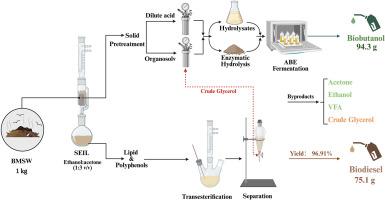从城市固体废物中可持续生产生物丁醇和生物柴油:优化和工艺整合
IF 5.8
2区 生物学
Q1 AGRICULTURAL ENGINEERING
引用次数: 0
摘要
本研究的重点是同时生产生物丁醇和生物柴油,这是在城市环境中使用的汽油和柴油的可行替代品,旨在提高城市固体废物(MSW)作为原料的价值。该工艺包括多阶段预处理,包括抑制剂和脂质同时提取,稀酸和粗甘油预处理,酶解后使用醋酸丁酸梭菌厌氧发酵生产生物丁醇。使用生物柴油的副产品粗甘油作为绿色溶剂进行预处理,减少了对昂贵的传统溶剂的需求。确定了丙酮、丁醇和乙醇(ABE)产量最高的最佳条件是脂质提取和乙醇去除抑制剂,然后在120°C下1% w/w的稀酸预处理10 min。在此条件下,发酵预处理液的丙酮浓度为5.42 g/L,丁醇浓度为11.32 g/L,乙醇浓度为1.35 g/L。此外,发酵水解产物的浓度为2.13 g/L丙酮,4.28 g/L丁醇和0.78 g/L乙醇。结果表明,制备生物柴油的最佳工艺条件为醇油比为9.14:1,反应温度为59.5℃,催化剂用量为0.886%,反应时间为67 min。在此条件下,乙醇与丙酮的比例为1:3,生物柴油的收率可达96.91%。总体而言,这种综合方法每千克城市生活垃圾产生137.2克ABE和75.1克生物柴油,表明城市生活垃圾作为双级生物燃料生产的可持续原料的潜力。本文章由计算机程序翻译,如有差异,请以英文原文为准。

Sustainable production of biobutanol and biodiesel from municipal solid waste: Optimization and process integration
This study focuses on the simultaneous production of biobutanol and biodiesel, viable alternatives to gasoline and diesel used in urban settings, aiming to enhance valorization of municipal solid waste (MSW) as the feedstock. The process involves a multi-stage pretreatment including simultaneous extraction of inhibitors and lipids, dilute acid and crude glycerol pretreatment, and enzymatic hydrolysis followed by anaerobic fermentation using Clostridium acetobutylicum for biobutanol production. The use of crude glycerol, a biodiesel byproduct, as a green solvent in the pretreatment, reduces the need for traditional costly solvents. Optimal conditions were determined for the highest production of acetone, butanol, and ethanol (ABE) were lipid extraction and inhibitor removal by ethanol followed by 1 % w/w dilute acid pretreatment at 120 °C for 10 min. Under these conditions, fermentation of the pretreatment liquid yielded concentrations of 5.42 g/L acetone, 11.32 g/L butanol, and 1.35 g/L ethanol. Moreover, fermentation of the hydrolysate resulted in concentrations of 2.13 g/L acetone, 4.28 g/L butanol, and 0.78 g/L ethanol. Moreover, the optimal conditions for biodiesel production were determined as methanol-to-oil ratio of 9.14:1, temperature of 59.5 °C, catalyst percentage of 0.886 %, and reaction time of 67 min. Under these conditions, a high yield of biodiesel (96.91 %) was achieved from the extracted oil using ethanol:acetone ratio of 1:3. Overall, this integrated approach produced 137.2 g of ABE and 75.1 g of biodiesel per kg of MSW, demonstrating the potential of MSW as a sustainable feedstock for dual-grade biofuel production.
求助全文
通过发布文献求助,成功后即可免费获取论文全文。
去求助
来源期刊

Biomass & Bioenergy
工程技术-能源与燃料
CiteScore
11.50
自引率
3.30%
发文量
258
审稿时长
60 days
期刊介绍:
Biomass & Bioenergy is an international journal publishing original research papers and short communications, review articles and case studies on biological resources, chemical and biological processes, and biomass products for new renewable sources of energy and materials.
The scope of the journal extends to the environmental, management and economic aspects of biomass and bioenergy.
Key areas covered by the journal:
• Biomass: sources, energy crop production processes, genetic improvements, composition. Please note that research on these biomass subjects must be linked directly to bioenergy generation.
• Biological Residues: residues/rests from agricultural production, forestry and plantations (palm, sugar etc), processing industries, and municipal sources (MSW). Papers on the use of biomass residues through innovative processes/technological novelty and/or consideration of feedstock/system sustainability (or unsustainability) are welcomed. However waste treatment processes and pollution control or mitigation which are only tangentially related to bioenergy are not in the scope of the journal, as they are more suited to publications in the environmental arena. Papers that describe conventional waste streams (ie well described in existing literature) that do not empirically address ''new'' added value from the process are not suitable for submission to the journal.
• Bioenergy Processes: fermentations, thermochemical conversions, liquid and gaseous fuels, and petrochemical substitutes
• Bioenergy Utilization: direct combustion, gasification, electricity production, chemical processes, and by-product remediation
• Biomass and the Environment: carbon cycle, the net energy efficiency of bioenergy systems, assessment of sustainability, and biodiversity issues.
 求助内容:
求助内容: 应助结果提醒方式:
应助结果提醒方式:


